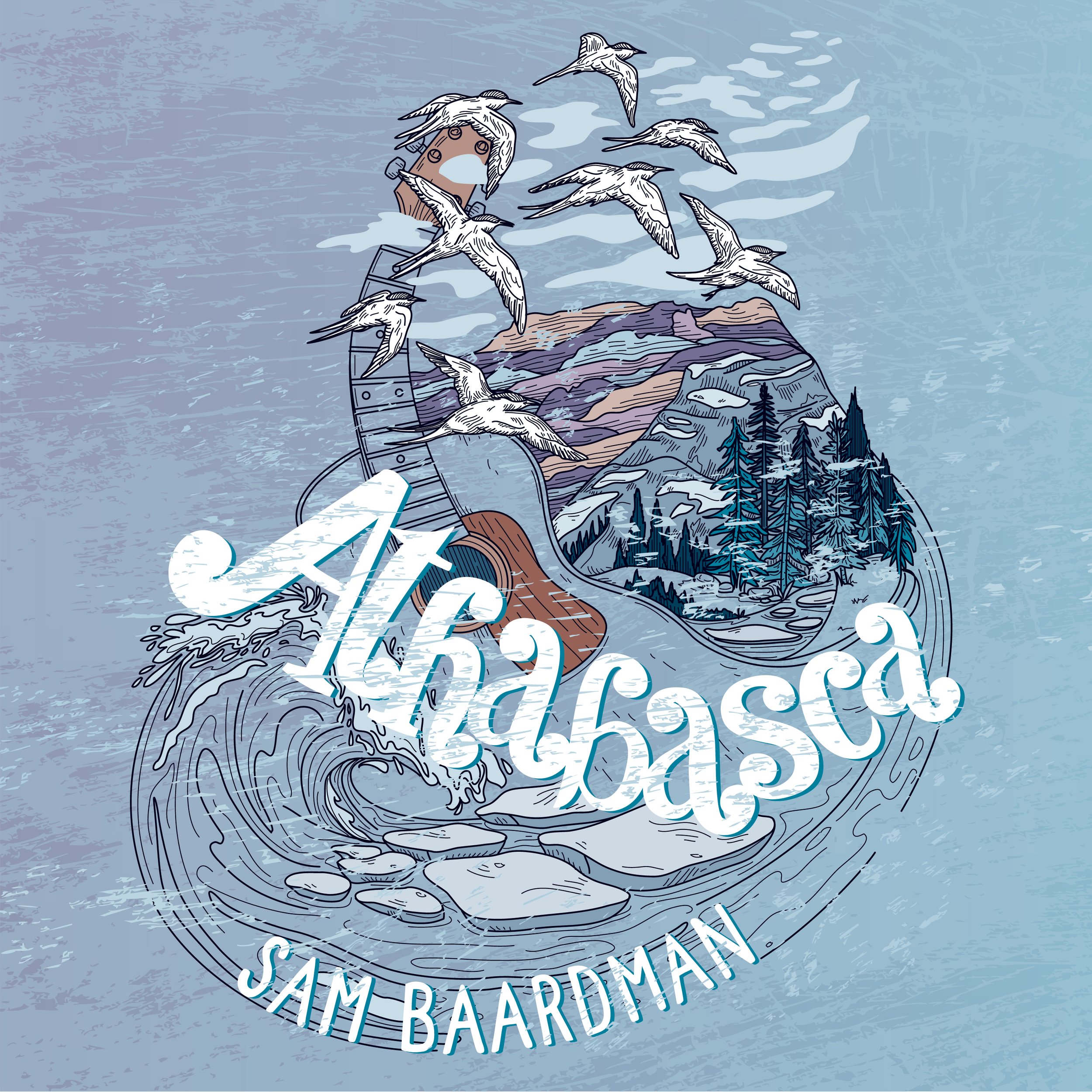
Athabasca - An Album of Eco-Songs
After meeting Sam at a conference called “Art, Activism and Advocacy” in Winnipeg, Louise Arnal of Global Water Futures invited him to spend two weeks last fall at the Coldwater Laboratory in the Rockies as well as the Centre for Hydrology in Saskatchewan to speak with GWF scientists about their work. The result of this science-art collaboration is Athabasca, a collection of environmental songs that was released on April 22, 2023, Earth Day. Much of the album was written from notes made while meeting with GWF scientists. The songs are thoughtful, poetic, and sometimes biting commentary on the current environmental crisis. There are celebratory songs about the beauty of nature, songs about specific issues impacting water systems, and also songs that speak to our bewilderment, hurt, and anger at the dilemma we find ourselves in.
The album can be purchased at www.sambaardman.com. Or you can listen on any of your favourite streaming services.
Athabasca - Songwriter’s Notes
1) Riverborne
I grew up in Winnipeg, a city founded at the confluence of two beautiful prairie rivers, the Red and the Assiniboine. This song is a celebration of rivers in all their forms, and the life that thrives along their banks.
2) Still Life Town
In my conversations with GWF scientists, we shared our perplexity and sadness at the widespread lack of concern about the ecological catastrophe that is upon us. Still Life Town is a song about how we all seem to be sleep-walking through the crisis. As cars disappear into the fog, the tone is quiet and still. How do we account for our somnambulism in the midst of humanity’s greatest emergency?
3) Not Like We Didn’t Know
Environmental science is not new. The first calculations related to the impact of carbon on atmospheric temperature were done in the 19th century. Environmental science as a field emerged strongly in the 1960s, and caused public outcry not long after. By now, more than half a century later, as sea-levels rise, and millions are ravaged by wildfires, severe storms, droughts and floods, we can't say that we didn't know it was coming. Countless scientists have been carefully gathering evidence and raising the alarm for over a century now. We owe it to them, and to ourselves, to act faster and do more.
4) Spring Song
This song is another celebration of nature. But where most songs about spring happily rejoice in the warmth of the season, this song has a foreboding sub-text. Spring has a strange, chaotic feeling, and with every new year, the whole world feels more turbulent and unpredictable. It’s an odd metaphor for climate change, but there it is. All we can do is keep breathing, and hope.
5) Lake Winnipeg
Lake Winnipeg, the 10th largest lake on the planet, is now considered to be the most threatened of the world's great lakes. Eutrophication is causing annual toxic algae blooms of 10,000 square kilometres or more. If we stay on our present course, the lake’s entire eco-system will collapse. The eutrophication process is well-known, and the steps needed to remediate the problem are also known, but we aren’t doing enough, or acting quickly enough. As we watch the lake decline, we have to get serious about restoring this sacred, beautiful lake. Millions of wild things are depending on us.
6) Athabasca
This song is a meditation on my experience accompanying Dr. John Pomeroy, Maddie Harasyn and Kieren Lehan, as they climbed the Athabasca Glacier to do maintenance on some hydro-meteorological equipment that is monitoring the state of the glacier. The glacier began forming a quarter million years ago, but now, sadly, it will likely be gone in 50 years time. “Athabasca” is a warning for how the loss of the glaciers will affect the broader environment, and a lament for lost beauty.
7) Feel-Good Factory
This is a song about being trapped in a market system that is predicated on overconsumption and excess. As we burn through the world’s resources, it’s hard not to see this out-of-control consumerism as an addiction that is being deliberately fed and sustained by forces beyond our control. All of it leads to a severe dissociation from the natural systems that truly feed us in fundamental ways. How will we finally escape this culture, and how will we re-connect with what’s really important?
8) Sick Sedition
The terrible effects of right-wing populism on science are easy to document. Denialism, disinformation, and conspiracy-thinking are all leading to a dissolution of faith in scientific truth, established facts, and academic and other public institutions. At the very time when we need to act together to address the ecological crisis, these forces are tearing us apart. There was a time when the best response was to confront purveyors of this kind of muck head on. But times have changed. Now it seems best not to give them oxygen and to just walk away.
9) Two Feet in Wavey Creek
Many years ago, spreading across southern Manitoba, there was a vast system of wetlands, marshes and bogs. Rivers, brooks and other waterways coursed through the landscape, including Wavey Creek, which wound its way through the marshland into Lake Winnipeg’s southern basin. Eventually, Europeans came and found a land that wasn’t hospitable to agriculture and settlement. So, the wetlands were drained. Wavey Creek became a ditch, carrying agricultural runoff into the great lake to the north. Lake Winnipeg is dying without the filtering wetlands of the past. Only a remnant remains of the great marshlands. And a remnant of beautiful Wavey Creek too. We need to work together to preserve what is left, and restore what we can.
10) Beautiful World
In the continual fight for ecological justice and environmental reform, it is easy to succumb to hopelessness. In fact, the Mental Health Commission of Canada now recognizes eco-anxiety as a unique syndrome. We can begin to cope by reminding ourselves of the earth’s beauty and the wonder of life, and opening ourselves to the miracles and the marvels that surround us daily.
As part of this science-art project, Sam Baardman journeyed through diverse research sites, from the Athabasca glacier and the Fortress Mountain Research Basin in Alberta, to the Clavet Livestock and Forage Centre of Excellence, St. Denis National Wildlife Area and Wanuskewin Heritage Park in Saskatchewan. Scientists at these locations delve into the intricacies of water and ecosystems, studying snowpack changes, glacier melt, groundwater flow, and beaver dams. This research aims to understand changes and their impacts on society, influencing aspects like drinking water availability, agriculture, and landscapes management. Sam captured firsthand insights from scientists during his visits. Explore testimonials from some of the scientists who shared a day in the field with Sam during his visit:
“As Sam and I trekked across Athabasca glacier, we chatted about using drone technology to monitor the rapid recession of glaciers in the Rocky Mountains, and how drones provided a different vantage point for looking at our changing world. While hiking across a glacier, its easy to see the effects of climate change from the rapid run off of glacial melt water and cracking ice at the toe of the glacier, however the magnitude of change becomes much clearer when you can see a bird’s eye view of the collapse of a glacier.” - Madison Harasyn
”Fortress Mountain Research Basin has been an integral part of understanding mountain hydrology in the Canadian Rockies. Spending the day with Louise and Sam showcasing the history of this area and our research operations within was very special after my 9 years of research involvement here. Spending time at Fortress and its field sites is inspiring, thought provoking and provides a great setting for connecting the public with science.” - Lindsey Langs
Several of these research sites are part of a broader network, and you can discover additional information about it here.
Sam Baardman is a singer-songwriter and photographer living in Winnipeg, Manitoba. He is a co-founder of “River on the Run”, a group of artists that creates work based on their shared experience of living within the Lake Winnipeg watershed. Integrating a variety of art forms and disciplines, and working in collaboration with biologists and climate scientists, their work investigates the increasingly fragile relationship between humans and their habitats. Environmentalism has been an enduring theme both in Sam’s music and visual art. His music is known for its lyrical depth and superb, singable melodies, while his photography has been exhibited in galleries in both Canada and the U.S.
Louise Arnal is a water scientist with a lifelong love of art. She is a postdoctoral fellow with Global Water Futures, as part of which she is leading the Virtual Water Gallery project. She enjoys exploring water-related topics using scientific tools on her computer and a diversity of artistic media (from watercolour paintings to multi-sensory immersive installations). You can see some of Louise's science and art projects on her website and connect with her on Twitter and on Instagram.
Professor John Pomeroy is a Distinguished Professor in the Dept. of Geography & Planning, the Canada Research Chair in Water Resources and Climate Change, the Director of the Global Water Futures Programme, and the Director of the University of Saskatchewan Coldwater Laboratory in Canmore (Alberta, Canada). His current research interests are on the impact of land use and climate change on cold regions hydrology and water quality, and improved prediction of climate change impacts, especially floods and droughts.
Contact Us!
Want to share your comments, questions or perspectives on this gallery and the themes explored? Please Contact Us!
The Virtual Water Gallery team is committed to providing a safe, respectful, harassment-free, and accessible space for all. We do not tolerate harassment of any member of society.




